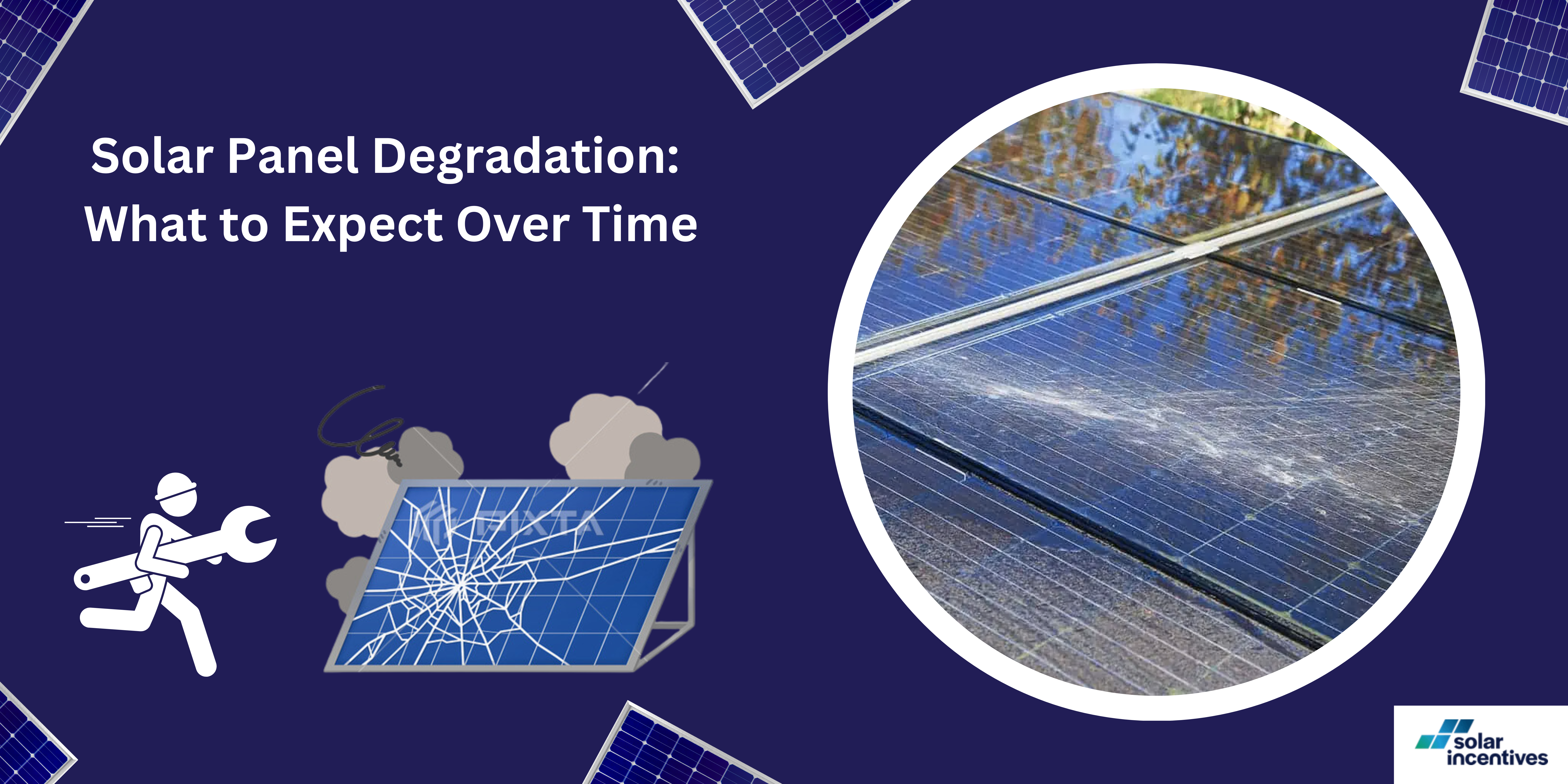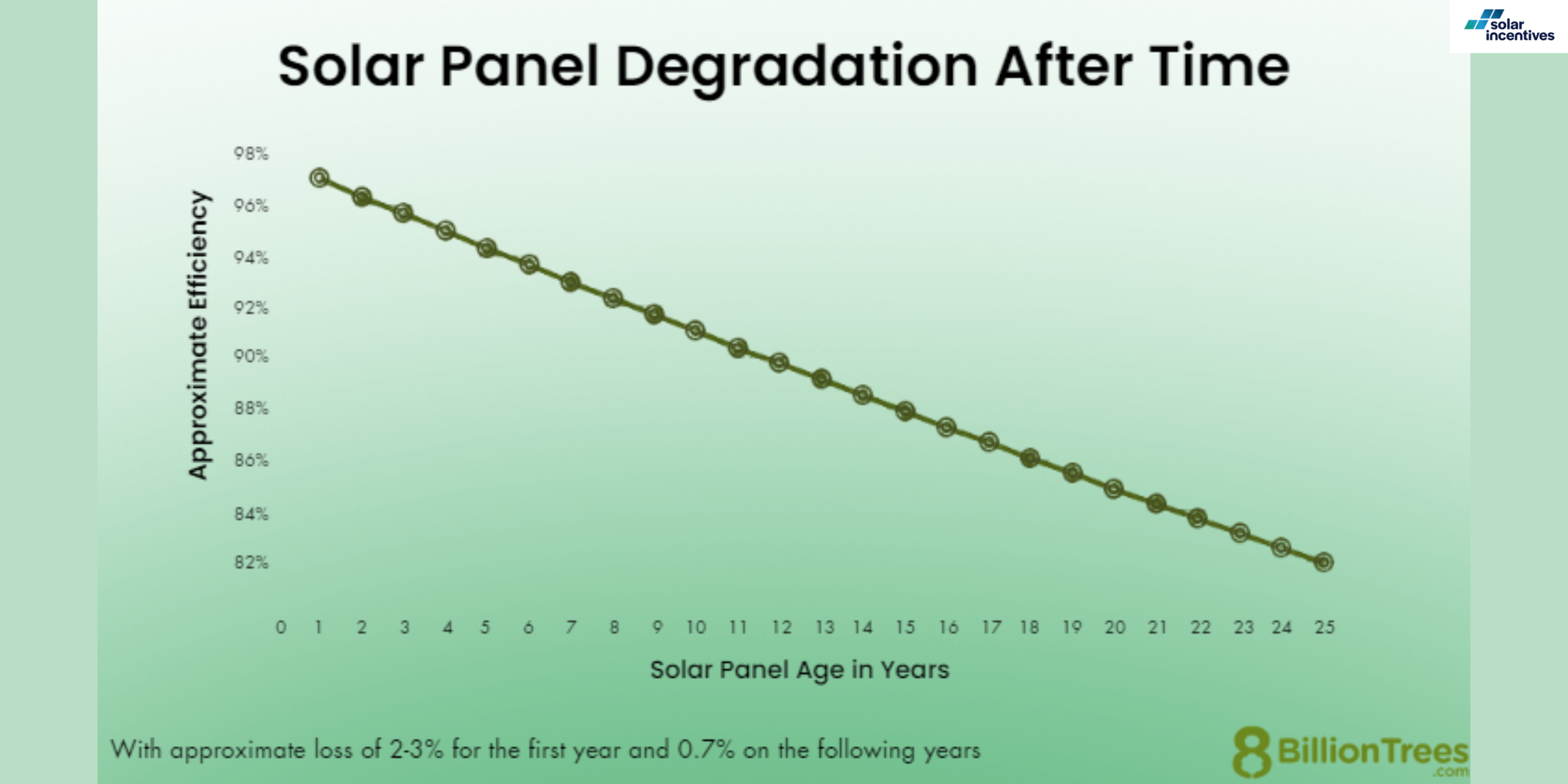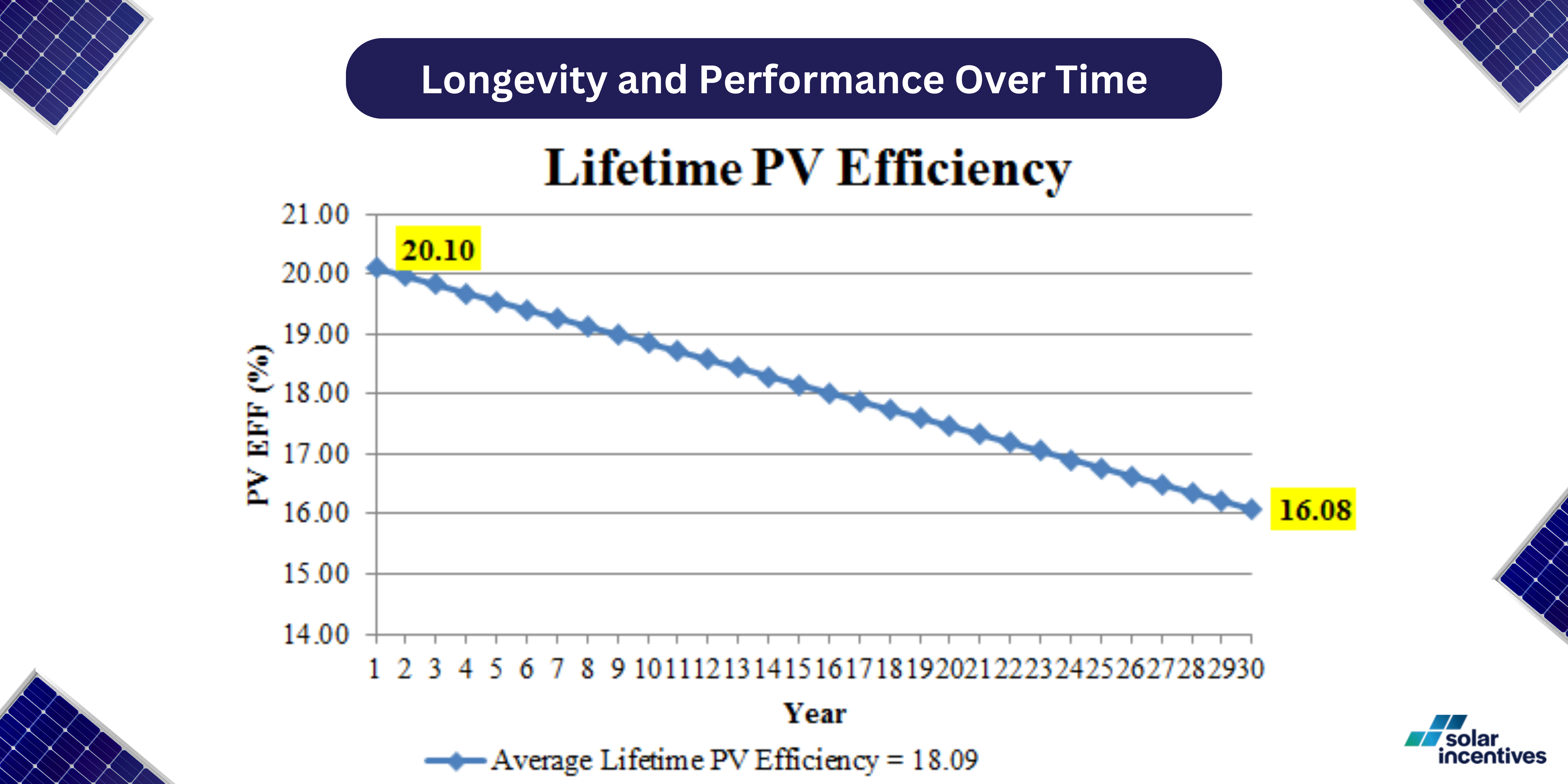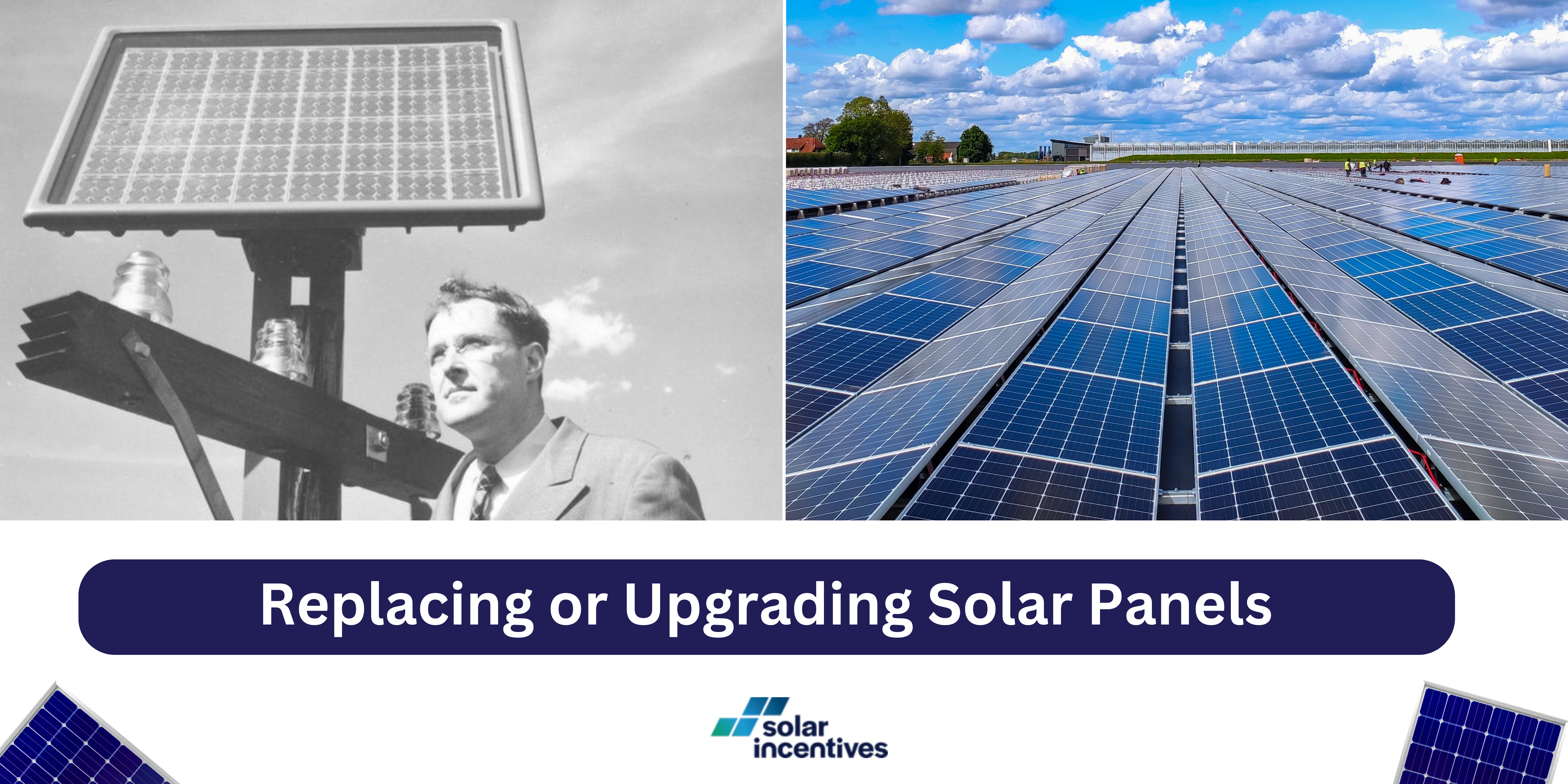Solar Panel Degradation: What to Expect Over Time

Steve Hill
Expert in Residential and Commercial Solar Solutions and Energy Efficiency
4 min read · 14th December 2023

At first glance, solar panels might seem like a set-and-forget solution to green energy. However, like all technology, they change over time. A critical aspect of these changes is solar panel degradation.
A natural, gradual process where the efficiency and effectiveness of solar panels decrease. This isn’t a sign of a faulty product; rather, it’s an expected part of a solar panel’s lifecycle.
Understanding degradation is crucial for anyone who owns or is considering investing in solar panels. It’s not just about acknowledging that solar panels won’t last forever.
It’s about understanding how this gradual decline affects long-term performance. And overall return on investment of your solar energy system.
A clear grasp of how solar panels degrade over time will help you make informed decisions. Whether it’s about maintenance, budgeting, and eventual replacement. In this article, we’ll dive deep into what solar panel degradation is.
We’ll discover what causes it, the average rates at which it occurs, and how you can manage it.

Solar Panel Degradation: Contributing Factors

Solar panel degradation is influenced by a variety of factors. Each of these factors plays a role in how quickly and severely the efficiency of a solar panel declines. Understanding these factors is key to managing and anticipating the lifespan of your solar energy system.
Environmental Impacts:
Exposure to the Elements
Solar panels are constantly exposed to environmental conditions like sunlight, rain, wind, and even snow. This continuous exposure can cause wear and tear over time.
Temperature Variations
Extreme temperatures, both hot and cold, can affect the panels. High temperatures, in particular, can accelerate the degradation process.
Physical Damage
Events such as hailstorms or debris carried by strong winds can cause physical damage to the panels, impacting their efficiency.
Manufacturing Quality
Materials Used
The type of materials used in the manufacturing of solar panels significantly affects their durability. Higher quality materials generally offer better resistance to degradation.
Manufacturing Processes
The technology and processes used in the production of solar panels also contribute to their longevity. Advanced manufacturing techniques can lead to more durable, less susceptible to degradation panels.
Installation and Maintenance
Quality of Installation
How solar panels are installed can influence their susceptibility to degradation. Improper installation can lead to issues like water ingress or increased stress on the panels.
Maintenance Regime
Regular maintenance can mitigate some degradation effects. Neglecting maintenance, on the other hand, can accelerate degradation.
Chemical Degradation
UV Exposure
Prolonged exposure to UV radiation can degrade the chemical composition of solar panels, affecting their performance.
Corrosion
In coastal areas, salt mist can lead to corrosion of metallic parts of the panel, further contributing to degradation.
System Design and Quality
System Configuration
The overall design of the solar power system, including how panels are linked and angled, can affect degradation rates.
Inverter Quality
The quality of inverters and other system components can also impact the longevity of the panels.
By understanding these factors, you can take proactive steps to minimise degradation. At the same time maximise the efficiency and lifespan of their solar energy systems.
Average Degradation Rates
Understanding the average degradation rates of solar panels is essential for anyone looking to invest in or currently owning a solar power system. Degradation rate refers to the percentage decrease in electrical output or efficiency that a solar panel experiences each year.
Typical Degradation Rates
The average solar panel degradation rate is generally between 0.5% and 1% per year. This means that a panel producing at 100% efficiency in its first year would be expected to produce around 99.5% to 99% of that output in its second year, and so on.
It’s important to note that these rates can vary based on several factors such as the quality of the solar panel, environmental conditions, and maintenance practices.
Variations Among Brands and Types
Different brands and types of solar panels show different degradation rates. For instance, monocrystalline panels are often found to degrade slower than polycrystalline panels.
Some premium brands offer panels with degradation rates as low as 0.3% per year. This highlights the importance of choosing a reputable brand for long-term efficiency.
Industry Standards and Research
The International Electrotechnical Commission (IEC) provides standards for measuring solar panel degradation. These standards help in comparing different panels and understanding what to expect in terms of performance over time.
Studies and field tests have been conducted to understand solar panel degradation. For example, a study by the National Renewable Energy Laboratory (NREL) in the United States provides extensive data on how different types and brands of panels degrade over time.
By keeping these factors in mind, you can better understand what to expect from your solar panels over their lifespan.
Signs of Solar Panel Degradation

Detecting solar panel degradation early is crucial for maintaining the efficiency and longevity of your solar energy system. While some signs of degradation are visible, others are more subtle and require close monitoring. Here’s how you can identify the signs of degradation and take appropriate action:
Visual Signs of Degradation
Discoloration
Look out for any yellowing or browning, especially in the backsheet of the panel. This can indicate that the panel is degrading due to UV exposure.
Delamination and Snail Trails
Delamination, where layers of the solar panel start to separate, and snail trails, which are silver or brown discoloration lines, often signal degradation.
Microcracks
These small cracks can be hard to see with the naked eye but can significantly impact the panel’s performance.
Performance-Related Signs
Decreased Power Output
Monitor your electricity bills and energy output reports. A consistent decrease in energy production is a clear sign of degradation.
Inconsistent Performance
Fluctuations in power output, even in ideal weather conditions, can also indicate problems.
Monitoring Solar Panel Efficiency
Use of Monitoring Systems
Install a solar monitoring system to keep track of your system’s performance. These systems can alert you to significant changes in output.
Regular Check-ups
Periodic physical inspections of your panels can help spot early signs of wear and tear.
Consulting a Professional
Routine Professional Inspections
Even with diligent monitoring, it’s wise to have a professional inspect your solar panels periodically. They can detect issues that might not be obvious to the untrained eye.
Seeking Expert Advice
If you notice any of the above signs or if your monitoring system reports a substantial drop in efficiency, it’s time to consult a solar energy expert. They can assess whether the degradation is within normal bounds or if it’s an indication of a more serious issue.
By being vigilant and proactive in monitoring your solar panels, you can identify signs of degradation early on. This allows you to take necessary actions like maintenance, repair, or even replacement – to ensure your solar energy system continues to operate at its best.
Mitigating Degradation Effects
Ensuring your solar panels maintain their efficiency for as long as possible involves proactive measures to mitigate degradation effects. Here’s how you can extend the life and performance of your solar panels:
Maintenance Tips to Prolong Solar Panel Life
Regular Cleaning
Dirt, debris, and bird droppings can obstruct sunlight and cause hot spots on the panels, leading to accelerated degradation. Cleaning your panels regularly can prevent this.
Periodic Inspections
Regular inspections can help identify and address issues like loose connections, corrosion, or damage that might contribute to faster degradation.
Preventive Measures
Implementing measures like pest guards can prevent damage from animals, which can lead to degradation.
Impact of Installation Quality and Location
Professional Installation
Ensuring your solar panels are installed by certified professionals can greatly reduce the risk of degradation. Proper installation prevents issues like water ingress and structural stress.
Optimal Placement and Angle
The location and angle of your solar panels affect their exposure to the sun and weather elements, impacting their rate of degradation. For instance, panels installed in a position that avoids pooling water can have a longer lifespan.
Technological Advancements to Reduce Degradation
Anti-Reflective Coatings
These coatings can reduce the loss of sunlight due to reflection, thereby maintaining efficiency and reducing degradation.
Improved Panel Design
Advances in solar panel technology, such as bifacial panels or better encapsulation materials, can also help in reducing the rate of degradation.
Smart Monitoring Systems
Modern solar systems often come equipped with smart monitoring technologies that can provide real-time data on panel performance, allowing for early detection and response to any signs of degradation.
Longevity and Performance Over Time

A key consideration for anyone investing in solar panels is understanding their expected lifespan and how their performance will change over that period. This insight is crucial for calculating the long-term return on investment and planning for future energy needs.
Expected Lifespan of Solar Panels Considering Degradation
General Lifespan
On average, solar panels are designed to last about 25 to 30 years. However, this doesn’t mean they stop producing electricity after this period. It simply means their efficiency decreases to a level lower than what is considered optimal.
Degradation Impact
Considering the average annual degradation rate of 0.5% to 1%, a solar panel at the end of its 25-year lifespan might operate at around 75% to 87.5% of its original efficiency.
Factors Affecting Lifespan
It’s important to note that the lifespan can vary based on factors like panel quality, environmental conditions, and maintenance practices.
Comparing Initial Performance vs. Performance Over Time
Initial Years
In the first few years, high-quality solar panels maintain over 90% of their efficiency, often benefiting from warranties that guarantee this level of performance.
Mid-Life Performance
As the panels age, the degradation becomes more noticeable. You may start to see a slight but steady decline in the energy output on your monitoring systems.
Later Years
Towards the end of their lifespan, the decrease in performance becomes more apparent. However, well-maintained panels can still provide substantial energy output, albeit at a lower efficiency.
Replacing or Upgrading Solar Panels

Deciding when to replace or upgrade your solar panels is a crucial decision that can significantly impact your energy efficiency and financial returns. Here’s how to approach this important decision:
Deciding When to Replace or Upgrade
Age and Efficiency
Consider the age of your panels and their current efficiency. If they are nearing the end of their expected lifespan or their efficiency has significantly decreased, it might be time to consider replacement.
Damage or Malfunction
If your panels are damaged or not functioning properly, and repairs are not cost-effective, replacement is likely the best option.
Cost-Benefit Analysis of Replacement vs. Continued Use
Evaluating Costs
Assess the cost of new panels, including installation, against the expected increase in energy efficiency and savings on electricity bills.
Return on Investment
Consider how the improved efficiency of new panels could offset the replacement costs over time, and compare this to the diminishing returns of older, less efficient panels.
Latest Advancements in Solar Panel Technology
Higher Efficiency Panels
Newer solar panels offer higher efficiency, which means more energy generation even in limited spaces.
Improved Durability
Advances in materials and construction mean newer panels might be more durable and have longer lifespans.
Smart Technology Integration
Modern panels often incorporate smart technology, allowing for better monitoring and management of energy production.
Conclusion
Throughout this article, we’ve explored the critical aspects of solar panel degradation. We’ve covered the causes and signs of solar panel degradation. Discussed strategies for mitigation. And the significance of monitoring panel efficiency over time.
As solar panel owners, it’s vital to be proactive in managing your solar energy system. Regular upkeep, keeping up with new technology, and knowing when to update or replace your panels.
Understanding solar panel degradation helps maximize your investment and supports sustainability. As Australia leads in clean energy, better solar management contributes to a greener, more energy-secure nation.
For more information on finding the right solar solution for your needs and to learn about government incentives that can help reduce costs, visit Solar Incentives Australia and check out the Solar Program. Let’s harness the power of the sun to its fullest potential, slashing electricity bills and boosting energy security for years to come.
Article By
Steve Hill
Steve Hill has a rich background in the solar energy sector and is dedicated to empowering consumers with knowledge, particularly in residential and commercial solar solutions, solar batteries, and energy efficiency products.
Steve enjoys sharing his wealth of experience, offering practical advice, and learning about the latest trends and innovative solutions in the world of solar energy.

